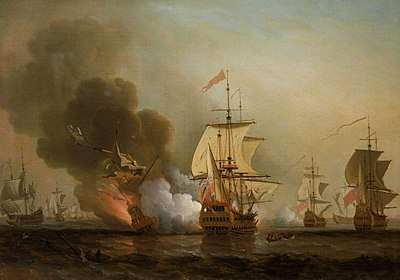HMS Expedition (1679)
HMS Expedition was a 70-gun third-rate ship of the line of the Royal Navy, launched at Portsmouth Dockyard on 10 September 1679.[1][5]
_during_Wager's_Action_off_Cartagena%2C_28_May_1708_(cropped).jpg) HMS Expedition | |
| History | |
|---|---|
| Name: | HMS Expedition |
| Builder: | Furzer, Portsmouth Dockyard |
| Launched: | 10 September 1679 |
| Renamed: | HMS Prince Frederick, 1715 |
| Fate: | Sold, 1784 |
| General characteristics as built[1] | |
| Class and type: | 70-gun third-rate ship of the line |
| Tons burthen: | 1,059 tons BM |
| Length: | 152 ft 1 in (46.4 m) (gundeck) |
| Beam: | 40 ft 9 in (12.4 m) |
| Depth of hold: | 17 ft (5.2 m) |
| Sail plan: | Full-rigged ship |
| Armament: | 70 guns of various weights of shot |
| General characteristics after 1699 rebuild[2] | |
| Class and type: | 70-gun third-rate ship of the line |
| Tons burthen: | 1,116 tons BM |
| Length: | 152 ft 1 in (46.4 m) (gundeck) |
| Beam: | 40 ft 10 in (12.4 m) |
| Depth of hold: | 17 ft 1.5 in (5.2 m) |
| Sail plan: | Full-rigged ship |
| Armament: | 70 guns of various weights of shot |
| General characteristics after 1714 rebuild[3] | |
| Class and type: | 1706 Establishment 70-gun third-rate ship of the line |
| Tons burthen: | 1,116 |
| Length: | 150 ft (45.7 m) (gundeck) |
| Beam: | 41 ft (12.5 m) |
| Depth of hold: | 17 ft 4 in (5.3 m) |
| Sail plan: | Full-rigged ship |
| Armament: |
|
| General characteristics after 1740 rebuild[4] | |
| Class and type: | 1733 proposals 70-gun third-rate ship of the line |
| Tons burthen: | 1,225 |
| Length: | 151 ft (46.0 m) (gundeck) |
| Beam: | 43 ft 5 in (13.2 m) |
| Depth of hold: | 17 ft 9 in (5.4 m) |
| Sail plan: | Full-rigged ship |
| Armament: |
|
Expedition was rebuilt as a 70-gun third rate in 1699 at Chatham Dockyard.[2] She was rebuilt for a second time as a 70-gun third rate to the 1706 Establishment at Portsmouth Dockyard, and was relaunched on 16 August 1714. She was renamed HMS Prince Frederick after Frederick, Prince of Wales in 1715.[3] Her final rebuild was carried out at Deptford, where she was reconstructed as a 70-gun third rate to the 1733 proposals of the 1719 Establishment.[4]
She was the flagship at Wager's Action a naval confrontation on 8 June 1708 N.S (28 May O.S.), between a British squadron under Charles Wager and the Spanish treasure fleet, as part of the War of Spanish Succession.[6]
The Prince Frederick was part of Vice-Admiral Edward Vernon's fleet and took part in the expedition to Cartagena de Indias during the War of Jenkins' Ear, 1739 to 1748.
Prince Frederick was sold out of the navy in 1784.[4]
Notes
- Lavery, Ships of the Line vol.1, p162.
- Lavery, Ships of the Line vol.1, p166.
- Lavery, Ships of the Line vol.1, p168.
- Lavery, Ships of the Line vol.1, p171.
- "British Third Rate ship of the line 'Expedition' (1679)". Threedecks. Retrieved 27 August 2019.
- "Wager's Action off Cartagena, 28 May 1708". Royal Museums Greenwich. Retrieved 19 March 2019.
References
- Lavery, Brian (2003) The Ship of the Line - Volume 1: The development of the battlefleet 1650–1850. Conway Maritime Press. ISBN 0-85177-252-8.
